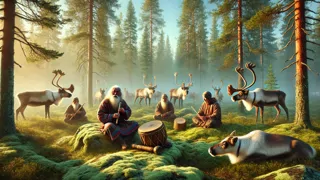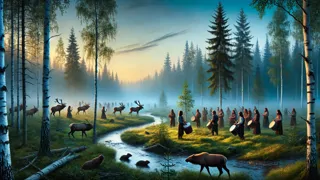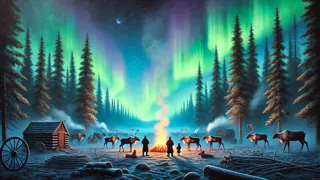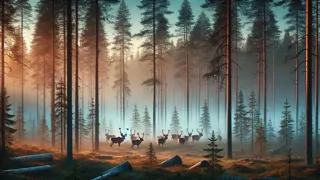Introduction
Beneath the towering pines of Karelia, where shadows weave into silver mist at dawn, the reindeer roam in hushed reverence. Their hooves leave soft impressions on moss-carpeted trails, and their breath rises like gentle smoke into curling dawn light. In remote villages at the forest’s edge, elders pass on an ancient sung heritage: a sequence of notes said to awaken forgotten streams, coax saplings from wounded soil, and beckon creatures back to once-silent glades. Young listeners lean close as voices rise—low, lilting refrains that fold over winding rivers and echo off lichen-clad stones. Each melody is a gift, balanced between human hands and the hooves of nature’s guardians. In this living legend, the forest itself joins the chorus, its tall trunks vibrating with the resonance of reindeer calls. As the tale unfolds, readers will journey alongside forest stewards, musicians, and ancestral spirits, learning how one simple song can become a powerful act of rewilding and stewardship. From hidden winter groves to summer meadows ablaze with fireweed, this introduction sets the stage for an odyssey through landscapes torn by modern strain and renewed by the timeless harmony of song and earth.
Melodies of the Ancient Herd
The forest hummed with expectancy as the village musicians carried their wooden flutes toward a clearing at the heart of Karelia. Tall spruce trunks formed a natural amphitheater, their bark mottled with lichen and time. Elders sat cross-legged on mossy stones, their faces etched by generations of winters and summers spent in a living world of bark, berry, and hoofbeats. Across from them, a dozen reindeer turned their gentle gaze on the assembled humans, their coats heavy with winter warmth, their breaths curling like wisps of cloud in the crisp air. Here, tradition demanded that every flute, every drum, be poured into a melody learned from the herd itself: an ancient call carried on instinct through centuries of migration and memory. At the elders’ nod, the first flute note rose—long, plaintive, and soft as a prayer. The reindeer stiffened, ears pricked, as if recognizing a hidden language. Then came the low drum, a heartbeat echoing the pulsing sap of the forest’s veins. When flute and drum aligned, a resonance spread like roots beneath the surface, reaching into dark hollows and rustling every needle on every branch. The reindeer responded by stamping their hooves in measured rhythm, as though dancing to the tune of creation.

As melodies unfurled, storytellers recited the lore of Ylvä, the ancestral stag spirit who once guided travelers across frozen rivers using song alone. Each verse traced Ylvä’s memory: his antlers a map of shining stars, his voice a living atlas of waterways and clearings. Those who sang in true harmony found hidden springs bursting forth, their waters clear as crystal. Saplings sprouted overnight by ancient stumps, eager for new life. And creatures long absent—the arctic hare, the pine marten, the great gray owl—returned to claim their place under the emerald canopy. Villagers marked these moments with feasts of berry bread and smoked fish, acknowledging that their songs were not mastery but partnership with the forest.
By dusk, the final chord faded among the trees and the clearing stilled. But the magic lingered: a silver path of glowworms along a fallen log, a fresh trickle where a dry streambed had cracked. In the hush that followed, humans and reindeer traded glances of quiet understanding. Each knew they had taken part in a ritual older than memory, a living thread weaving community, nature, and the very idea of stewardship into a single tapestry of song and promise.
Echoes in the Wild: Rewilding Songs
When spring’s thaw rippled across the Forest of Karelia, bringing rivers back to murmuring life, the music traveled farther than before. Guides carried handheld drums and reed whistles along newly opened animal trails, each melody intended to coax elk from deep ravines and invite wildflowers to colonize clearings left barren by logging. The songs served as both invitation and instruction: a pulse for beasts that lingered on the edge of abandonment, and an anthem for restoration teams working to replant spruce and birch among stumps scarred by past overharvest. Conservationists recorded the herd’s natural calls and wove them into restorative choruses, amplifying frequencies that encouraged beetles to aerate soil, birds to nest in young saplings, and beavers to build dams where streams ran thin.

Alongside these efforts, local families embraced hands-on learning. Children learned to hum the “Waterfall Staff’s Tune” by the riverbank, a melody said to encourage salmon to leaping migration. Elder women taught a lullaby for seedlings, a soft refrain whispered into seedbeds that then sprouted with unusual vigor. Each practice honored the reindeer’s ancestral role as keepers of the forest’s equilibrium: they not only carried the songs but embodied their living spirit. Through daily dawn gatherings, villagers measured progress by the glimmer of new green shoots, by fresh tracks on untouched snowfields, and by the resurgent song of the forest itself.
By midsummer, the rewilding song had become a communal heartbeat. Every note stitched a broken landscape back together, turning abandoned clearcuts into corridors of life. Trees planted in once-barren knolls stood tall, their canopies dancing with wild pollinators. Streams, guided by humble song, meandered into overgrown wetlands, creating sanctuaries for amphibians and cranes. At night, the combined hum of insects, birds, and reindeer calls formed a living chorus that echoed through the darkness, a testament to what humans and nature could achieve when they sang from the same page.
Harmony Restored: A New Forest Song
By autumn, the Forest of Karelia had transformed. Where once loggers’ scars lay open, fresh vegetation thrived. Flocks of migrating cranes spiraled above wetlands brimming with life, and lynx tracks crisscrossed mossy glades. In villages, the new generation carried flutes to school, learning both forestry science and ancestral verses. Their instructors, human and reindeer alike, taught that every melody held a responsibility: to listen as much as to sing. Seasonal festivals drew neighbors from beyond the pine-shadowed borders. They gathered around a towering bonfire, singing a collaborative song composed jointly by ethnomusicologists and indigenous storytellers, blending modern science with ancient reindeer refrains.

This final composition, known as the “Harmonium of Karelia,” wove together the earlier melodies—the Waterfall Staff, the Seedling Lullaby, and the ancestral Ylvä Chant—into a single epic refrain. It told of loss and renewal, of human hands making amends, and of reindeer spirits guiding the melody back to the heart of the forest. As the notes rose, steam curled from the bonfire into a star-studded sky, and the herd stepped forward, their silhouettes luminous under aurora glow. The villagers watched in awe as a gentle hush fell, broken only by the soft chorus of singing trees.
When the last notes drifted into the night, a breathless silence followed. Then, as if on cue, the forest exhaled: tree tops rustled in approving applause, owls hooted in distant boughs, and a single reindeer let out a melodic call that rippled across the clearing. In that moment, the boundary between song and soil, between human and herd, dissolved entirely. Harmony—once a fragile promise—stood restored. And the new forest song, carried forward by every generation, would ensure that Karelia’s wild heart beat strong for centuries to come.
Conclusion
As snow blankets the Forest of Karelia once more, the echoes of its enchanted songs endure. Every note carries a promise: that human hands, guided by ancestral wisdom and the steadfast spirit of reindeer, can heal wounds inflicted on the land. The Harmonium of Karelia lives in children’s laughter, in the murmur of revived streams, and in the rustle of birch leaves under a crimson dawn. Generations will remember the melodies that rekindled a forest’s heartbeat, and in every flute lesson and drum circle, they will honor the lesson that true stewardship begins with listening. In this living legend, ecology and culture entwine, weaving a tapestry of hope that proves the wild will always find a song if we lend it our voices.

















